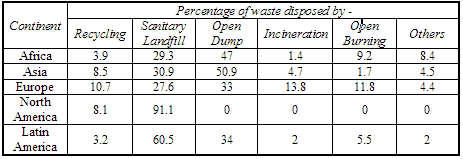
Info Sheets |
Waste Management: Fact Sheet
Key Figures
- Worldwide figures for municipal wastes vary considerably due to inconsistent statistics and definitions. Municipal solid wastes (MSW) in general constitute about 14-20 percent of all wastes generated worldwide, with other waste types including construction and demolition wastes (30%), manufacturing (20%), mining and quarrying (23%), and others.
- Per capita generation of waste varies with a high of 5.3 kg/day for OECD countries to less than 0.8 kg/day in developing countries. But changing life styles, ineffective policies, lack of awareness etc. may mean that this rate will increase exponentially over the next decade.
- UNEP's publication GEO-3 shows the MSW generation in Asia and the Pacific in 2032, using four scenarios - Market First, Policy First, Security First and Sustainability First - is expected to vary between 1.8 (for Sustainability First) and 2.5 (for Market First).
- Much of the wastes generated worldwide (57 to 85%) were primarily disposed in landfills, including open and engineered landfills. Other means of waste disposal included:
We see three worldwide trends - one, of waste volumes increasing, two, of waste qualities changing, with more inert and inorganic wastes being generated, and three, hazardous wastes also being included. For example, the Basel Convention has estimated that in its signatory countries, the amount of hazardous and related wastes generated for 2000 and 2001 was 318 and 338 million tons respectively.
The indiscriminate and improper dumping of MSW, often mixed with hazardous wastes like medical waste without treatment raises several serious environmental issues, including loss of renewable resources such as metals, plastic, glass; loss of potential resources such as compost from organic waste, and energy from burnable waste etc. Contamination of land and water bodies due to discharge of leachate and other hazardous materials, and air pollution due to emissions from burning and release of methane from anaerobic decomposition also remain as concerns. Risks to human health (respiratory problems, skin and other diseases, and longer term impacts due to dioxins etc.) and spreading of disease by vectors in areas near landfill sites are other critical issues.
An example of increase in recycling, and consequent decrease the amount of waste going for landfill, comes from Nova Scotia, Canada. In 1989, Canada set a target to halve the amount of MSW by the year 2000. As a result of a comprehensive Solid Waste Resource Management Strategy, Nova Scotia (641,575 tons in 2000) managed to reduce the waste sent to landfills and incinerators by 46 percent by increased recycling and composting.
The Payatas dump is Manila's largest garbage disposal site, receiving about 5000 tons of garbage everyday. Six mountains of garbage upto 15 metres high have been created. More than 80,000 slum dwellers live around this area, many earning their living as waste pickers. These residents face severe health problems such as typhoid, hepatitis, cholera, and other infectious diseases. In 2000 one of the hills collapsed due to heavy rains killing 205 persons. The dump site has been closed since 2004.
As a result of the problems associated with the proper disposal of wastes, there is a clear need for a multi-stakeholder partnership in proper and integrated waste management in all stages - collection, transportation, treatment, and disposal, but especially at the source where it is generated, and integrate it with policies that encourage the 3Rs -reduce, reuse and recycle.
Sources: Statistics are from UNEP-ISWA State of the Waste Industry, prepared for WSSD, Basel Convention Secretariat, United Nations Human Settlements Programme (UN Habitat) - Global Report on Human Settlements 2003, US Environment Protection Agency, Planet Ark World Environment News, United Nations Environment Programme and P. Beigl et.al. University of National Resources and Applied Life Sciences, Vienna, Austria .
| Return to Urban Waste Contact: Hari Srinivas - hsrinivas@gdrc.org |
